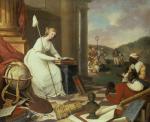![header=[Marker Text] body=[Born of white, Black and Native American descent, he bought his freedom and became a baker of bread for Revolutionary troops. A founder of the Free African Society, he later opened a school for Black children while living here.] sign](http://explorepahistory.com/kora/files/1/10/1-A-16E-139-ExplorePAHistory-a0a8q1-a_450.gif)
Mouse over for marker text
Name:
Cyrus Bustill (1732-1806)
Region:
Philadelphia and its Countryside/Lehigh Valley
County:
Philadelphia
Marker Location:
210 Arch St., City of Philadelphia
Behind the Marker
To break the American resistance during the War for Independence, British officials attempted to lure enslaved African Americans into the British Army by promising them their freedom. In the South, tens of thousands of African Americans ran away to the British Army, but it is unclear how many slaves in Pennsylvania took advantage of this offer.
At the same time, Pennsylvania's small community of nearly 500 free blacks had to make their own decisions about whether to support independence or the Crown. During the American Revolution, many free blacks in Pennsylvania sided with the struggle for independence in order to secure greater rights and privileges than they enjoyed under British rule.
In many respects, Cyrus Bustill, a mulatto who was born into bondage and later purchased his freedom, represented the principles for which the American Revolution was fought. As a free black man, he was caught in a precarious position between slavery and freedom. While Bustill shared some of the rights and privileges of other free men, he also confronted special legal, economic, and social restrictions.
The legal principle that color was sufficient grounds for presuming slave status made free blacks vulnerable to kidnapping and sale back into slavery. Even if they managed to escape the ruthlessness of the slave catcher, free blacks such as Bustill still faced discrimination as well as competition from slave, indentured, and free white labor.
When the Revolutionary War broke out, Bustill was one of just 5,000 African Americans who joined the nearly 230,000 soldiers of the Continental Army. Unlike Edward Hector, who saw action at the Battle of Brandywine, Bustill served behind the lines as a baker for the troops. But like Hector, he entertained the same hope that Pennsylvania would reward his military service by better protecting his liberty and equality.
Edward Hector, who saw action at the Battle of Brandywine, Bustill served behind the lines as a baker for the troops. But like Hector, he entertained the same hope that Pennsylvania would reward his military service by better protecting his liberty and equality.
After the Revolution, Bustill's hope was partially realized when the Pennsylvania legislature passed a gradual abolition act in 1780. According to that measure, all slave children born in Pennsylvania after March 1st of that year would immediately be emancipated when they reached the age of twenty-eight. By 1800, all but fifty-five of Philadelphia's more than 6,400 blacks were free.
In 1787, Bustill joined with African American minister and civic leader Richard Allen to organize the
Richard Allen to organize the  Free African Society. Dedicated to the mutual aid, support, and development of leaders within the city's growing black community, the Free African Society raised funds to establish black churches and provided relief for "the free Africans and their descendants of the City of Philadelphia." It also made crucial connections in the white community and gathered new recruits, including many ex-slaves, to operate organizations of their own making that would assume a guardianship role over the conduct of the city's blacks.
Free African Society. Dedicated to the mutual aid, support, and development of leaders within the city's growing black community, the Free African Society raised funds to establish black churches and provided relief for "the free Africans and their descendants of the City of Philadelphia." It also made crucial connections in the white community and gathered new recruits, including many ex-slaves, to operate organizations of their own making that would assume a guardianship role over the conduct of the city's blacks.
Denied entry into Philadelphia's white schools, members of the Free African Society established their own, including Bustill, who, in 1803, opened a school in his own home on Third Street in the northern part of the city.
At the same time, Pennsylvania's small community of nearly 500 free blacks had to make their own decisions about whether to support independence or the Crown. During the American Revolution, many free blacks in Pennsylvania sided with the struggle for independence in order to secure greater rights and privileges than they enjoyed under British rule.
In many respects, Cyrus Bustill, a mulatto who was born into bondage and later purchased his freedom, represented the principles for which the American Revolution was fought. As a free black man, he was caught in a precarious position between slavery and freedom. While Bustill shared some of the rights and privileges of other free men, he also confronted special legal, economic, and social restrictions.
The legal principle that color was sufficient grounds for presuming slave status made free blacks vulnerable to kidnapping and sale back into slavery. Even if they managed to escape the ruthlessness of the slave catcher, free blacks such as Bustill still faced discrimination as well as competition from slave, indentured, and free white labor.
When the Revolutionary War broke out, Bustill was one of just 5,000 African Americans who joined the nearly 230,000 soldiers of the Continental Army. Unlike
After the Revolution, Bustill's hope was partially realized when the Pennsylvania legislature passed a gradual abolition act in 1780. According to that measure, all slave children born in Pennsylvania after March 1st of that year would immediately be emancipated when they reached the age of twenty-eight. By 1800, all but fifty-five of Philadelphia's more than 6,400 blacks were free.
In 1787, Bustill joined with African American minister and civic leader
Denied entry into Philadelphia's white schools, members of the Free African Society established their own, including Bustill, who, in 1803, opened a school in his own home on Third Street in the northern part of the city.





